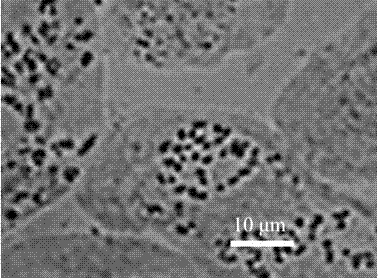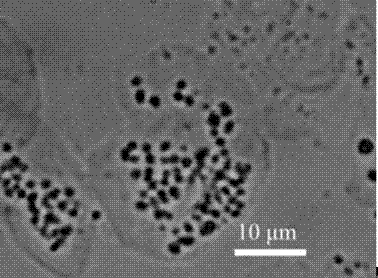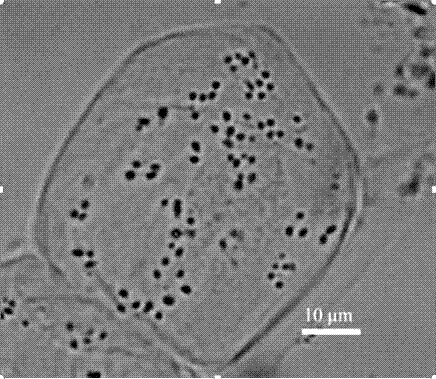Method for preparing conventional slide of chromosomes from grapevine root tips
A chromosome and grape root technology, applied in the field of cytogenetics, can solve the problems of the small number of grape chromosomes and the limitations of chromosome research, and achieve the effects of reducing cytoplasmic viscosity, large dispersion space, and easy counting
- Summary
- Abstract
- Description
- Claims
- Application Information
AI Technical Summary
Problems solved by technology
Method used
Image
Examples
example 1
[0032] The diploid Lihongbao grape root tip dyeing chromosome compression method comprises the steps in the following order:
[0033] (1) When cultivating materials, choose robust annual Lihongbao branches during winter shearing. After three months of winter sand storage, take out the branches and cut the branches into cuttings with a length of 10-12cm, leaving 2-3 buds for each cutting. , when cutting the cuttings, the distance between the upper notch and the upper bud is 1.5~2 cm, cut horizontally, the lower notch is close to the cut part, cut obliquely, completely immerse the cuttings in clean water for 24 hours, until the cut section is bright green, Take out and drain, and immerse the base downward in 100 mg / L naphthalene acetic acid solution for 24 hours to promote rooting. Put the cuttings into conical flasks for cultivation at a water depth of 2-4 cm, and place them in a light incubator with a light intensity of 2000 Lx, light for 12 h, culture at a constant temperatur...
example 2
[0042] The triploid Nyahei root tip chromosome compression method comprises the steps in the following order:
[0043] Steps 1 and 2 are the same as in Example 1.
[0044] Step 3: Fix the pretreated Xiahei root tip material with distilled water for three times, and then place it in Carnot’s fixative (V absolute ethanol: V glacial acetic acid=3:1, Carnot’s fixative is prepared and used now), Fix at 4°C for 36 h.
[0045] Step 4 Dissociation Take out the fixed Xiahei root tip, wash it three times with distilled water, put it in a 2 mL centrifuge tube, then add 3.5% mixed enzyme solution (same as in Example 1) to the centrifuge tube, mix the enzyme solution and the root tip The volume ratio of 30:1, 37 ℃ constant temperature enzymatic hydrolysis for 25 minutes, then rinsed with distilled water 2~3 times, placed in distilled water for later use.
[0046] Steps 5, 6 and 7 are the same as in Example 1. Microscopic examination results and photomicrographs see figure 2 .
example 3
[0048] The tetraploid Jingya root tip chromosome compression method includes the steps in the following order:
[0049] Except that the fixed time in step 3 was 48 h, and the dissociation and enzymatic hydrolysis in step 4 were 30 min, the rest of the steps were the same as in Example 2. Microscopic examination results and photomicrographs see image 3 .
[0050] The results of the above implementation and application on three representative grape varieties show that this method is an effective method for conventional grape chromosome compression, and the compression method is simple and convenient to operate, the chromosomes are evenly dispersed, the background is light, and the number of chromosomes is easy to obtain. Counting, the number of chromosomes obtained by this method has high accuracy.
PUM
 Login to View More
Login to View More Abstract
Description
Claims
Application Information
 Login to View More
Login to View More - R&D
- Intellectual Property
- Life Sciences
- Materials
- Tech Scout
- Unparalleled Data Quality
- Higher Quality Content
- 60% Fewer Hallucinations
Browse by: Latest US Patents, China's latest patents, Technical Efficacy Thesaurus, Application Domain, Technology Topic, Popular Technical Reports.
© 2025 PatSnap. All rights reserved.Legal|Privacy policy|Modern Slavery Act Transparency Statement|Sitemap|About US| Contact US: help@patsnap.com



